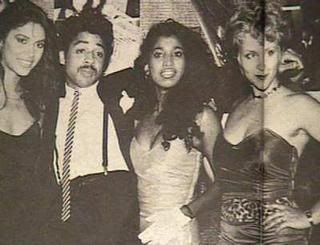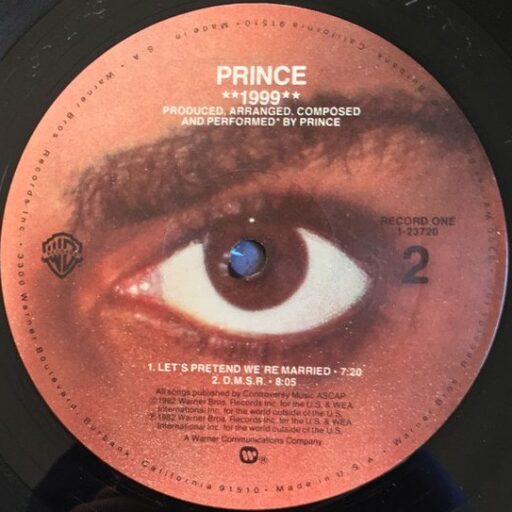The Time’s first album was completed quickly, even by Prince’s ever-increasing standards: recorded in April 1981, mixed (at Hollywood Sound Recorders in Los Angeles) by the end of the month, and released another three months later. In the meantime, the man behind the curtain was already devising a second group of protégés: an all-female counterpart to his first group’s male pimp aesthetic, charmingly named the Hookers.
In order to recruit his stable of Hookers, Prince stayed even closer to home than he had for the Time. He drafted his personal assistant, Jamie Shoop, who then-engineer Don Batts described as “a good-looking blonde… kind of a ballsy woman in a man’s world” (Nilsen 1999 63). The other two spots were filled by his girlfriend at the time, Susan Moonsie, and her sister Loreen.

Biographies often describe Susan, a Trinidadian-born schoolteacher’s daughter, as Prince’s “high school girlfriend”–which is accurate, if what one really means is “girlfriend who was in high school.” Per Nilsen wrote that Prince met her through his early assistant, Perry Jones, in 1979; this would have made her 15 years old. Their relationship began at some point in 1980, when Moonsie was 16; by 1981 and age 17–again, according to Nilsen–they were briefly engaged (Nilsen 1999 78).
It thus seems safe to assume that Prince wrote “She’s Just a Baby,” a tender ballad about loving a younger woman recorded in early 1981, with Moonsie in mind. The lyrics are standard “Girl, You’ll Be a Woman Soon” stuff–so, creepy. Prince croons about the judgment of others who “don’t understand what she sees in an older man,” but asserts, “Although she’s young / She’s the only one that can bring out the man in me.” In this post-R. Kelly, post-#MeToo era, it’s a lot to absorb.
But if one can get past the ick-factor, there’s a tenderness and loneliness at the heart of the song that I would be remiss to ignore. “She’s just a baby, a baby / But she’s my lady,” Prince sings in the opening verse, “My lover, my only friend.” Roy Bennett, Prince’s production designer in the early 1980s, recalled Moonsie as “a very sweet and very, very intelligent girl… Prince had a lot of respect for her and they had a great, very close relationship” (Nilsen 1999 78). An anonymous friend of Moonsie’s told Nilsen that “Prince and Susan had what could be considered a real relationship: two people who really love each other” (79).
Susan was a very sweet and very, very intelligent girl… Prince had a lot of respect for her and they had a great, very close relationship.
Roy Bennett

Prince, as we’ll see, did have a lifelong tendency to romantically engage much younger women–though as he got older, he would become much more scrupulous about not initiating sexual relationships until his partners turned 18. But his predilections seem less sexually deviant than pathological in some other, emotional way. In her 2017 memoir The Most Beautiful: My Life with Prince, Prince’s ex-wife Mayte Garcia writes about a letter he sent her in 1990, when she was 16 and he was 32: “U seem so kind and unaffected by this heartless planet we live on,” he wrote. Garcia speculates that his friendship with her as a much younger, more naïve person “was an oasis for him… a sanctuary unspoiled by sexual tension or the politics of sucking up” (Garcia 2017). While it seems perhaps a little too naïve to suggest that there was no sexual tension until she was of legal age, it’s easy to see how the innocence of youth could become an “oasis” for Prince as he grew older and increasingly embroiled in professional struggles.
There is also, of course, the inescapable fact that younger people, especially star-struck ones, are less independent and more emotionally malleable–hence, easier to control. In his own autobiography, then-guitarist Dez Dickerson recalled the replacement of Prince’s original keyboardist Gayle Chapman with 19-year-old Lisa Coleman as a pattern that continued, “at least in part, due to the fact that younger folks were more pliable” (Dickerson 107). A similar dynamic clearly pervaded his personal relationships. “As clichèd as it is for sexy older men to date younger women, I think his preference was more than physical; it was about the power balance,” Garcia writes. “He didn’t like to be argued with. He wasn’t used to someone banging on the door and saying, ‘I’m coming in! I don’t care what you say’” (Garcia 2017).
As clichèd as it is for sexy older men to date younger women, I think [Prince’s] preference was more than physical; it was about the power balance… He didn’t like to be argued with.
Mayte Garcia
But whether the song is a real glimpse of emotional vulnerability or just an Humbert Humbert-ian obfuscation of illicit desires, it should come as no surprise that Prince reportedly returned to “She’s Just a Baby” in 1991: a year into his increasingly romantic “friendship” with Mayte, and toward the end of his dalliance with Anna Fantastic, another striking young woman with the last name Garcia who he met when she was 16 and he was 30. Prince Vault tells us that he took the song out for additional recording and overdubs at Paisley Park, only to put it back in the Vault in favor of the similarly-themed “The Morning Papers.” Neither version of the song has been officially released, however, and the recording currently circulating seems to be the original take.

Were I a betting man, I’d wager that that original version of “She’s Just a Baby” was intended for The Time, or perhaps even the Nerve: the song’s vintage R&B vibe, the prominent vocal harmonies, and the low register Prince adopts for the bridge are all redolent of that album’s ballads. If that’s the case, it’s a shame it didn’t make the cut: it’s a markedly better song than either “Oh, Baby” or “Girl,” and its lyrical perspective of a down-to-earth young lothario with a heart of gold–or at least gold lamé–would have fit right in alongside tracks like “Get It Up” and “The Stick.” By the release of the Time’s second album, of course, Morris Day’s character had already evolved into an unrepentent cad: when that album’s opening track, “Wild and Loose,” discussed chasing after jailbait, it was with significantly less complex emotions.
As for the Hookers, we know that Prince recorded a batch of songs intended for that project in the summer of 1981, including “I Need a Man,” “Wet Dream,” “Drive Me Wild,” and “Make-Up.” The latter two tracks were intended for Susan to sing; they were shelved with the rest of the project, though, when Prince’s attention shifted to his own fourth album. By the time the girl group concept returned in early 1982, Jamie and Loreen were out and Susan was still in–along with a new, more age-appropriate paramour named Denise Matthews. But that’s a story for a different day.
Next time I post, we will finally get into Controversy. I promise!
“She’s Just a Baby”
YouTube

Leave a Reply